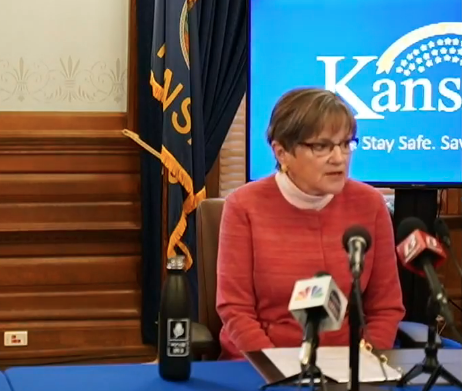
TOPEKA, Kan. (AP) — Kansas plans to start using 3D printers to manufacture its own swabs to test for the novel coronavirus as officials look to improve the state’s near-bottom national rank in testing before lifting a stay-at-home order.

Gov. Laura Kelly and her top public health administrator, Dr. Lee Norman, have complained for weeks that Kansas isn’t a priority for testing supplies and personal protective equipment from the federal government or even private vendors, making it difficult to get them.
The state’s struggles have continued with the Democratic governor under increasing pressure from the Republican-controlled Legislature to lift restrictions hindering economic activity, with her stay-at-home order set to remain in place until May 3.

But Kelly said Friday that testing people both with and without symptoms is key. Norman said the state might not be able to loosen restrictions until later in May, a couple of weeks after the Kansas outbreak’s expected late-April peak. Kelly’s stay-at-home order took effect March 30 and is set to stay in place until May 3.
“Our ability to test and contact trace must be much more robust before we can safely proceed to open,” Kelly said during her daily coronavirus news conference at the Statehouse.
Kansas as of Friday had reported testing about 17,000 of its 2.9 million residents for coronavirus, or 5.8 for every 1,000 residents, according to The COVID Tracking Project, a website managed by journalists and analysts, with The Associated Press among the contributors to the data. That rate is the second-lowest among states, just behind Virginia’s 5.75 per 1,000 residents and a little more than half of the national figure of 10.82 per 1,000 citizens.
Testing generally has been limited to people who are showing coronavirus symptoms, though it has expanded in a handful of the state’s 105 counties, including the biggest hotspots in the Kansas City area.
Dr. Beth Oller, a family-practice physician in Stockton, said it’s “ridiculous” that in her area of northwest Kansas, testing still isn’t recommended for people who know they’ve had close contact with an infected person but aren’t yet showing symptoms.
“It’s frustrating, but it’s the way it is right now,” she said. “There are still not enough tests.”
Norman said earlier this week that the state had spent “a lot of money” on testing supplies, though the health department didn’t specify the amount, and was awaiting on some shipments of supplies.
He also said the state expects to use 3D printers next week to start manufacturing 1,000 testing swabs a week. The state would like to do another 15,500 tests on people not showing symptoms to determine how prevalent coronavirus infections are in the general population, he said.
The state Department of Health and Environment, led by Norman, reported Friday that Kansas had 1,705 confirmed coronavirus cases in 66 of its 105 counties. That was an increase of 117, or 7.4% from Thursday, with cases in three additional counties.
COVID-19-related deaths also rose 5%, up four to 84, according to the department.
For most people, the new coronavirus causes mild or moderate symptoms that clear up in two to three weeks. For some, especially older adults and people with existing health problems, it can cause more severe illness and death.
Despite its low testing rate, Kansas’ rate of COVID-19 deaths is in the middle of the pack among states, 2.89 for every 100,000 residents as of Friday, ranking 26th, and against a national figure of 9.89.
“Always, we’re working on, what’s the pinch point, in terms of a our supply chain? Norman said Friday. “I really think that the floodgates will open up and be allowing much more broad testing within the next week.”
Meanwhile, President Donald Trump, eager to get the economy moving again, tweeted Friday, “The States have to step up their TESTING!”
“Well, we know that,” Kelly said when asked about the tweet. “We’ve known that for a long time.”
___




